The Brown-headed Cowbird is North America’s best known brood parasite. The female cowbird lays her eggs in the nests of many different species and those eggs and resulting young are cared for by the host birds, often at the expense of their own offspring. That parasitic relationship was demonstrated for me yesterday morning in Utah’s Wasatch Mountains.
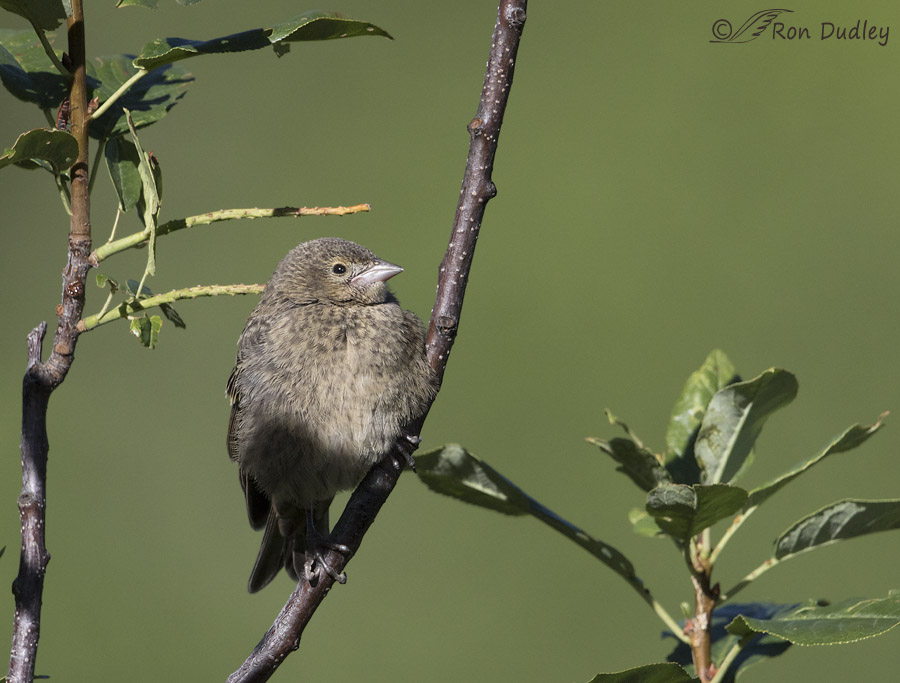
1/5000, f/5.6, ISO 800, Canon 7D Mark II, Canon EF500mm f/4L IS II USM +1.4 tc, not baited, set up or called in
On a visit to Cascade Springs I photographed this fledgling cowbird as it waited patiently for food to be delivered by its “adoptive parent”, which I believe in this case turned out to be a female Orange-crowned Warbler (I hadn’t yet had the chance to adjust my camera settings to the situation, thus the excessive shutter speed).
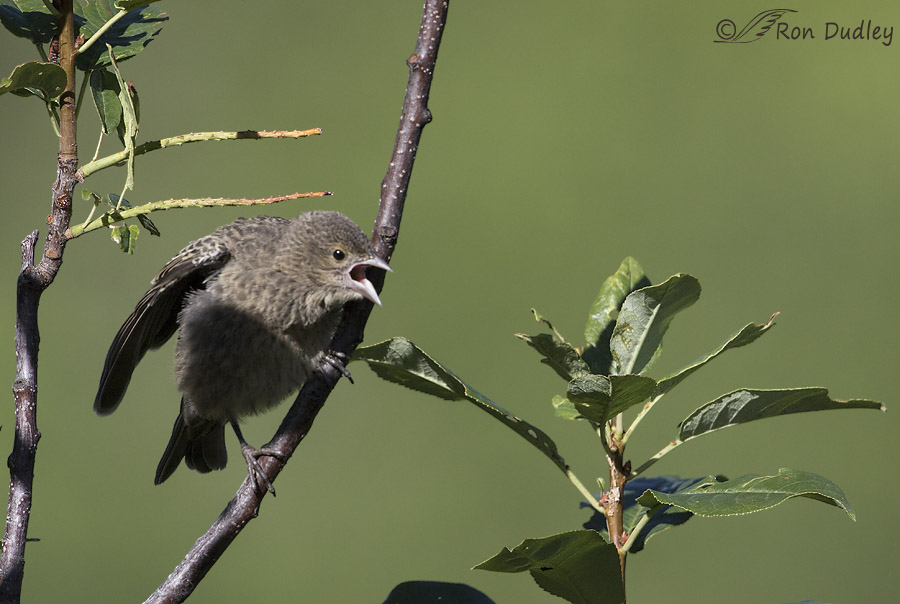
1/2500, f/6.3, ISO 500, Canon 7D Mark II, Canon EF500mm f/4L IS II USM +1.4 tc, not baited, set up or called in
The youngster’s patience disappeared quickly when it spotted the adult warbler returning with food and it began to beg aggressively…
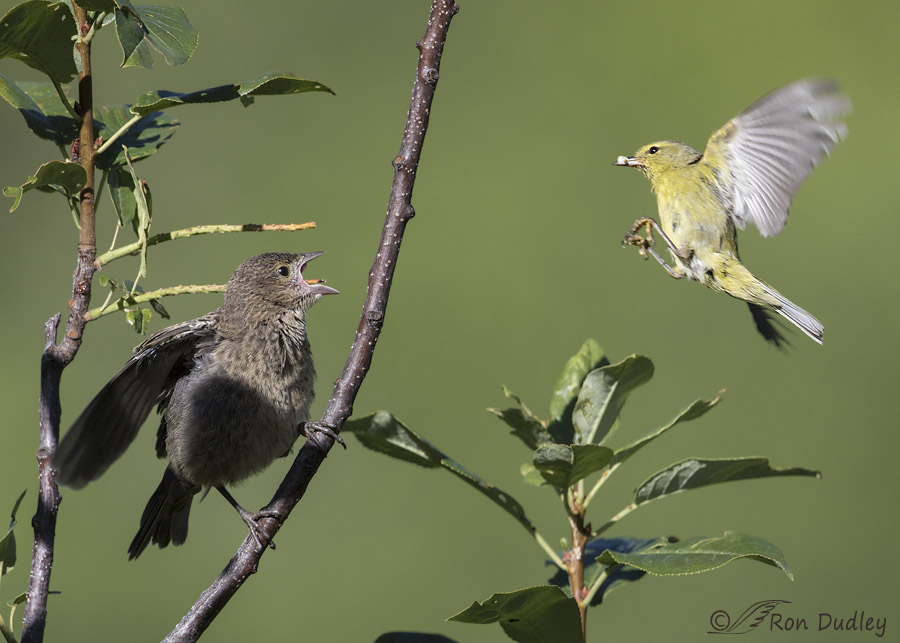
1/2500, f/6.3, ISO 500, Canon 7D Mark II, Canon EF500mm f/4L IS II USM +1.4 tc, not baited, set up or called in
as she approached.
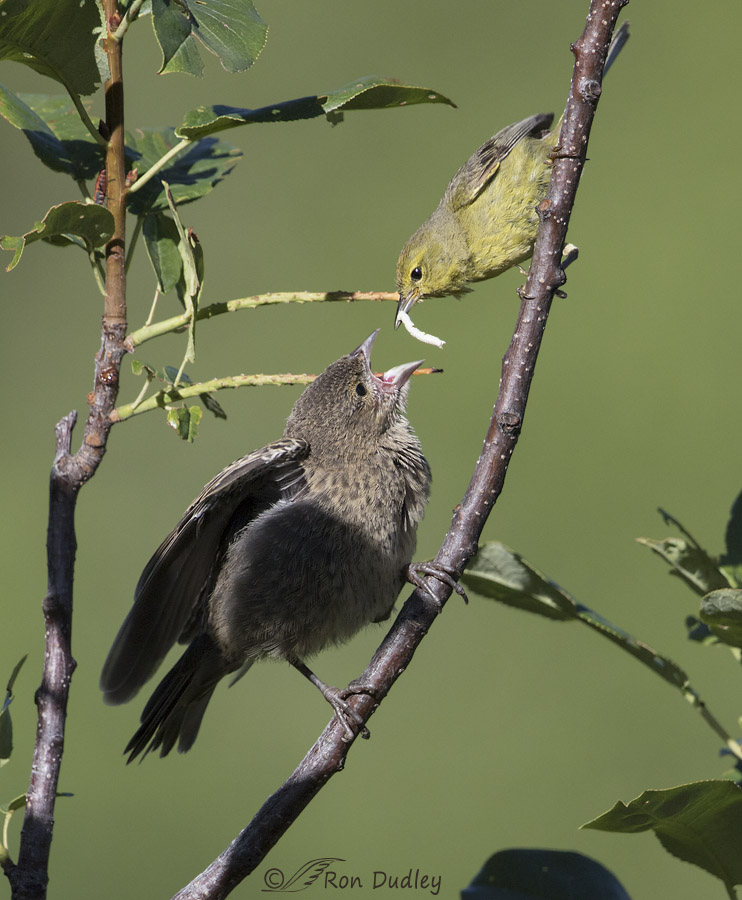
1/2500, f/6.3, ISO 500, Canon 7D Mark II, Canon EF500mm f/4L IS II USM +1.4 tc, not baited, set up or called in
The meal, one of the whitest worms or insect larvae I’ve seen, was…
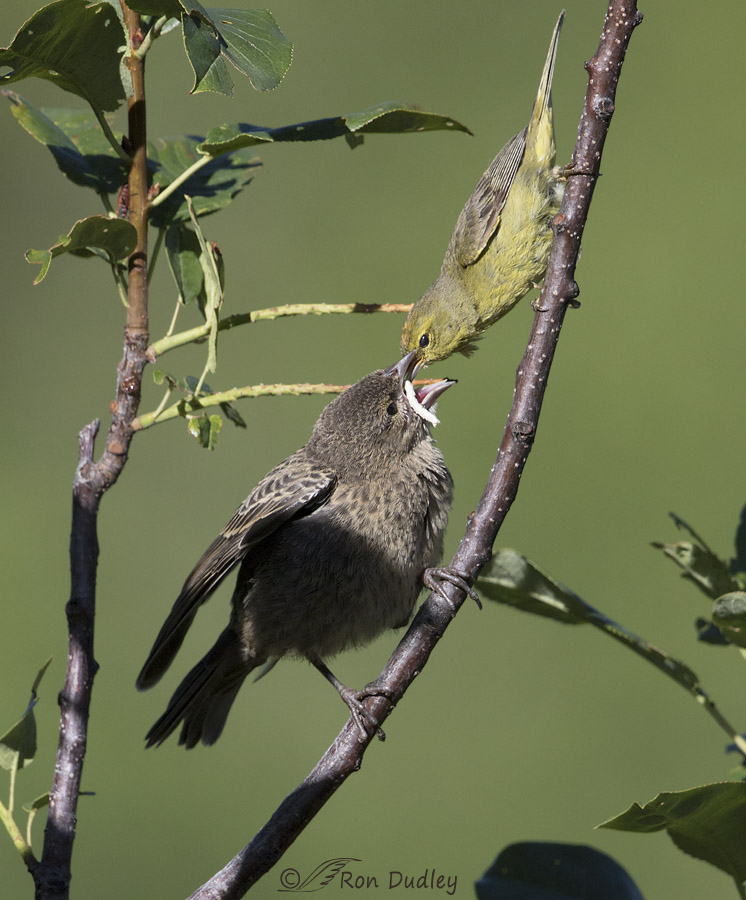
1/2500, f/6.3, ISO 500, Canon 7D Mark II, Canon EF500mm f/4L IS II USM +1.4 tc, not baited, set up or called in
enthusiastically accepted and gobbled down.
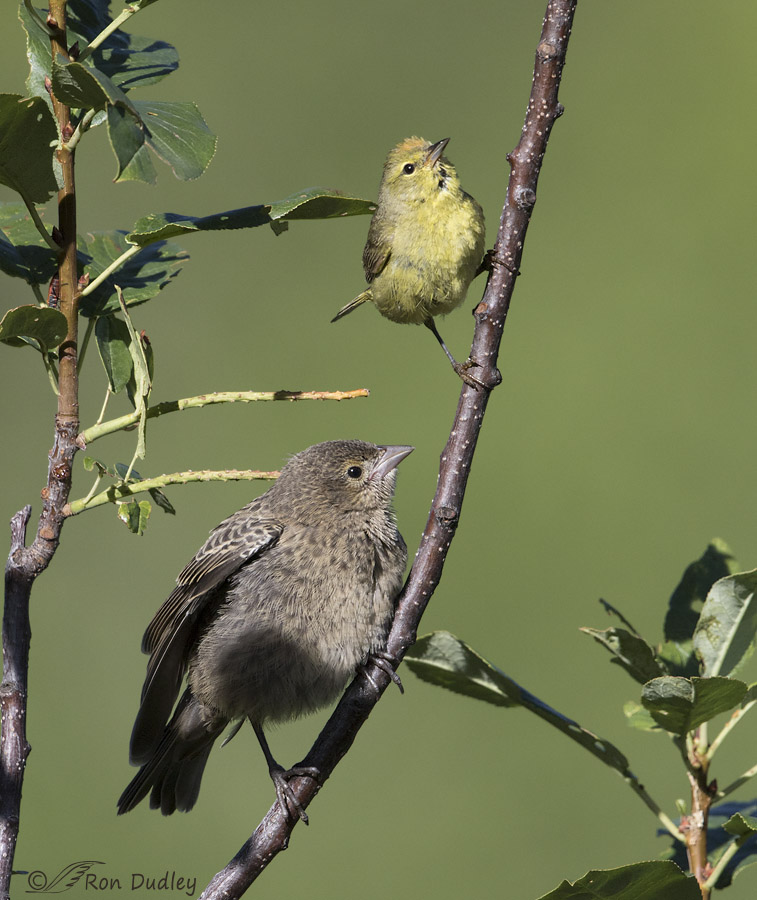
1/2500, f/6.3, ISO 500, Canon 7D Mark II, Canon EF500mm f/4L IS II USM +1.4 tc, not baited, set up or called in
I include this image for two reasons: It shows the massive size difference between parasite and host and it allows a look at some of the other field marks of the warbler. I’m unsure of my tentative ID of the adult bird so if anyone can confirm or correct it I’d be appreciative.
Because of their parasitic ways cowbirds are disliked by many but I just don’t feel that way. Parasitism is a natural relationship and I just see it as part of nature, neither good or bad. It just is. True, because of the massive habitat alteration caused by humans, cowbirds are parasitizing species in habitats that are historically new and that’s putting stress on some host species that aren’t yet equipped to handle it.
But I just can’t hold that fact against cowbirds. Others feel differently, I know…
Ron


No wonder parents get worn out.Great captures!
Fabulous documentation Ron! I find these types of interactions fascinating–oh, the wonder of nature
Impressive! both the photos and the size difference! Would love to capture such bird behavior.
Some of us just can’t stand to see a baby bird begging without stuffing something into that little fuzzy face. If we happen to be human, we are labeled as rehabilitators.
Another brilliant series.
At the end of the day, parasitism (if that is a word) is yet another survival technique. For which the bird cannot be blamed.
Simply amazing shots! I’ve witnessed the same with Northern Cardinals in our yard, but the size difference is incomparable to the difference in your shots.
Charlotte
Thanks, Charlotte. Yes, the size difference between these two is pretty jaw-dropping.
Since you were there taking these shots you must have seen the mate. Because the orange crown is absent on Most females and Immatures, and is very evident on picture #6 I suggest that this fellow is a male. Since Orange-crownes are drab to begin with the only significant ID mark we have here is the orange crown on number 6 and the hint of one on #5 as he is coming in with food.
The whole series is excellent. I’m one of those as a biologist that philosophically understand the concept, but emotionally feel it is really tough on those species, we as humans, have brought this parasitism upon. But that is a whole different topic!
Dick, I never did see the mate even though both sexes of the species feed young. There was this one feeding session with the cowbird and one warbler and then both birds disappeared and I never saw any of them again, even though I waited for them for quite a while.
You could be right and this could be the male – I just don’t know. BNA says that the crown patch “when present, concealed by greenish feather tips” and I presume this applies to both sexes so I didn’t use the patch to try to sex the bird. BNA also says that “Individuals with “intermediate” orange caps cannot be reliably sexed by cap alone”.
Thank you Ron, for the great photos and for your philosophical opinion on the behavior of brood parasites. When I first discovered cowbirds years ago while we were living in Portland, Oregon, I had a visceral reaction to them. Got so angry at their parasitic nature that I didn’t want to watch them at all. Now I know that, like all birds, cowbirds behave in ways that work for them. These days my concerns focus on the fact that some of these survival strategies work better than others, and as humans pave more of the planet the cowbird strategy, like the house sparrow, could win out big time. It was comforting to read Dan’s comment that cowbirds rarely hurt a birds overall population.
Cathryn, I try to appreciate, or at least tolerate, all native critters and their lifestyles and I usually succeed. But then there’s mosquitoes, biting gnats, ticks and a few others that truly test that philosophy…
Don’t forget leeches in the testing category.
EC, I put leeches in the “tolerate” category. I’ve only had one unpleasant incident with them and find their biology and adaptations fascinating. Another incident might put me over the top though…
AMazing, wonderful pictures of nature, Ron
Thanks for sharing
Glad you liked them, Linda. Thanks.
I must admit, the morality of bird “sleeper cells” is interesting, but I am just a bird photo “ho” as my students would say, so I am completely taken with the light and shadow of these, of course, just the behavior. I am all admiration, sir.
Morality is always interesting, but really, I’m just a bird photo “ho” as my students like to say. These are fascinating pictures whatever your moral views are. Wishing you a lovely, birdy weekend.
Thank you, Suzanne. Same back at ya!
sorry about the two posts. The server said the first one didn’t post, so I tried,tried again.
By the way, looking at these photos, that baby is cute, and it’s hard to hold its heritage/species against it.
I’m one of the ones who does not like cowbirds for that reason. Many years ago I watched a program on PBS where a Cowbird had parasitized the nest of a Prothonotary Warbler, and it got me very upset (for personal reasons that go back to my early years). Just seeing the title of this post stirred up all those feelings again, though it’s much easier for me to deal with in this situation, where the Cowbird baby is out of the nest. I wish I could become accepting of this kind of parasitism as just being nature (which it is). There are some influences in our lives which die very hard.
“There are some influences in our lives which die very hard.”
Yes, there certainly are, Susan – especially when they occur in our formative years…
I find myself in the minority and agree with you completely–Cowbirds, and other brood parasites are fascinating and I don’t find them “evil” as some birders do. They rarely hurt the overall population of the host species (Kirtland’s Warbler being one exception, but it’s just one of many hits for that species). For the Orange-crowned Warbler, the cowbird chick will be the only surviver, but this is not true for all hosts. Lazuli Buntings, for example, often succeed in raising one of their own chicks along with the cowbird. The Brown-headed Cowbird and Bronzed Cowbirds are generalists, seeking many host species, but the other cowbird species are more host specific. (Seven species of cowbirds, all in the America’s. One is not a parasite, but is host to another cowbird.)
There are many brood parasites around the world. Some, like cowbirds and cuckoos in Europe, are obligate parasites and have no choice but to seek a host nest in which to lay their eggs. Some are only parasitic occasionally, like the Redhead which frequently (up to 40% of the time) lays it’s in other duck’s nests, especially Canvasbacks. The whole topic is very fascinating and I have dedicated an entire chapter of my book to discussing it.
Another very interesting and informative comment, Dan. I too find the subject absorbing. One thing I wonder about is the evolution of the behavior. Just another niche to be exploited I guess but the details of the selection process must be fascinating if we knew them…
Cowbirds were historically a prairie species and get their name because of their association with bison (not domestic cattle). As the bison walk, they stir up insects which are readily snatched by the birds. Bison can move long distances quickly. So, it is very hard to keep up with the bison and still maintain a nest that would get farther from your food source each day.. By finding a host to raise your young, the lifestyle of closely following bison can be continued and the birds can exploit a food source others only occasionally share.
As our culture moved west, we altered the landscape. Cowbirds don’t like dense forests, but we have cleared those forests and created corridors that allowed cowbirds to expand. They have spread all across the country and found many new hosts that did not co-evolve with them. And, they have changed their feding habits to adapt to other food sources. But being brood parasites is no longer a matter of choice. It’s now part of their genetic makeup and cannot be altered, at least in the relatively short span of time that they moved from the prairies,
Thank you for this explanation, Dan. It really helps me in my effort to view Cowbirds differently.
Great info, Dan. Thank you!
This is a rare example of a specialized adaptation that has improved fitness even as the original conditions disappeared. Cowbirds developed parasitic nesting so they could stay with bison herds; now the bison herds are gone, yet the cowbirds have thrived and even expanded their range. Evidently this is a robust adaptation! And we also see songbirds developing strategies to avoid cowbird parasitism: some actually build new nests right on top of the parasitized one, eggs and all, and re-nest. The arms race continues… Evolution is endlessly fascinating.
Very well said, Tim – from start to finish of your comment. I loved it.
I haven no issues with the cowbird. It’s just doing what evolution dictated in the survival of the fittest. Perhaps we should consider ourselves to be the greatest parasite of all, as we continue to alter the planet to support ever more of our species. Human overpopulation: the elephant in the room that no one wants to address.
“Human overpopulation: the elephant in the room that no one wants to address”.
That’s an elephant that I’ve addressed my entire adult life, Gail – ever since I read Ehrlich’s “The Population Bomb” in the early 70’s. But you’re right – it is mostly ignored or sidestepped. And overpopulation is at the core of our problems IMO.
Amen to that! Thank you, Ron!
It’s hard for me to like Brown-headed Cowbirds. I try not to be judgmental because I know what you say is true–it’s just nature…and it’s not like they have any choice. It’s just hard to set aside my human sense of morality to simply see and appreciate them for what they are. I do the same thing when viewing videos of predators chasing down prey. If the predator is unattractive to me(like the hyena) I root for the prey to get away. If I find the predator beautiful (like the White-tailed Kite) I root for the predator.
That’s a pretty common and understandable reaction, Sharon. But I figure that if I’m not going to like cowbirds for being brood parasites I logically should apply the same standards to a host of other parasitic birds too – including some cuckoos, ducks, honeyguides, indigobirds and whydahs.
And I’ll admit that I’m sometimes not consistent in my outlook. I don’t like European Starlings in North America but it’s not their fault that they’re here…
I think differently…don’t like parasitism in much of any species, especially two-legged big ones…..
That’s ok, Patty. Different strokes…
Ron,
Try this website
http://merlin.allaboutbirds.org/photo-id
Crop that bird down and submit to this site (From Cornell) and if in there data base you will get a answer in seconds. But I tend to agree that it is a Orange Crowned Warbler.
Keep these blogs coming.
Dave
Good idea, David – thanks. I’ll do that later this morning when I get a few minutes. Right now things are a little hectic…
David, Ok, I used the link and the answer came back Orange-crowned Warbler. It didn’t ID sex but I know males and females are quite similar. Thanks again for the link – that’s a pretty nifty resource!
Great timing on that trip. I think Cowbirds are interesting. In fact, clever. Very interesting pictures Ron. Thanks!
Thank you, Jean.